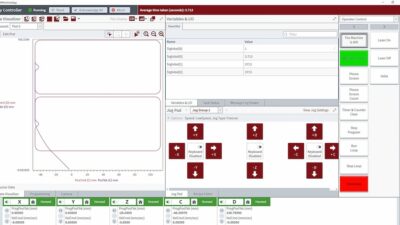Once upon a time, the term discrete sensor was synonymous with limit switches, but not any more. Today's discrete sensors are intelligent, rugged, accurately measure or sense many different things, provide all sorts of built-in protection, know how to communicate on a network, and still don't cost a lot of money.
Trends In Discrete Sensors
More rugged
Greater precision
Greater rangeability
Increased features
Once upon a time, the term discrete sensor was synonymous with limit switches, but not any more. Today’s discrete sensors are intelligent, rugged, accurately measure or sense many different things, provide all sorts of built-in protection, know how to communicate on a network, and still don’t cost a lot of money.
During February 2002, Cahners Research, using an independent firm, invited a select group of Control Engineering subscribers to participate in an online survey regarding discrete sensors. Responses were received from 434 subscribers. Survey results are based on the 386 respondents involved in the specification, recommendation, and/or purchase of discrete sensors.
Specific survey areas of interest included:
In-plant vs. OEM requirements;
Applications;
Current and future sensor usage;
Photoelectric sensor packaging;
Photoelectric sensor mode;
Selection criteria;
Operational modes;
Network usage;
Manufacturers purchased from;
Dollars spent; and
Current and future unit purchasing plans.
Among those specifying, recommending, and/or purchasing discrete sensors, 60% do so for in-plant requirements, 23% purchase for original equipment manufacturer (OEM) needs, and 18% purchase for both in-plant and OEM requirements.
Diverse applications
Discrete sensors are used in a wide variety of applications including machinery, fill-level, and fabricated metals. (See, ‘Where discrete sensors are used’ graph.)
The survey asked responders to indicate the most used discrete sensor type, current and future. Not too surprising, limit switches are the current most used (97%), followed closely by safety switches (93%). (See, ‘Current and future use by sensor type’ graph.)
Photoelectric sensor packaging preferences were also among the survey questions. Survey respondents indicate significant use of four packaging options-limit switch (65%), cylindrical (60%), miniature (59%), and fiber optic (53%).
Looking back at previous discrete sensor studies, the characteristics of corrosion resistance, wash-down protection, alignment/set-up aid, and short-circuit protection consistently rank highest in importance to survey respondents. (See ‘Important characteristic trends’ graph.)
However, in terms of rising importance, weld-field immunity has nearly doubled in importance between 1998 and 2002.
Network thoughts
Forty-two percent of survey respondents use sensors on a device- level network. Among those users, currently 71% apply DeviceNet protocol, followed by Ethernet TCP/IP (54%), Profibus (37%), AS-i (14%), Interbus (10%), and Seriplex (3%).
When asked what network they would choose if starting over, survey responders gave the first-place nod to Ethernet TCP/IP (60%), followed by DeviceNet (47%.), Profibus (25%), AS-i (13%), Interbus (8%), and Seriplex (3%).
Of those who connect sensors to a device-level network, 93% use standard sensors and an interface module.
Compared to other technologies, discrete sensors represent excellent value. The 386 survey respondents involved in the specification, recommendation, and/or purchase of discrete sensors spent an average of $18,436 to purchase 351 units each. That equates to a mere $52 per unit.
When you examine discrete sensor capabilities, that’s a lot of bang for the buck.
Discrete sensors
To request information on these products, visit www.controleng.com/freeinfo . For more manufacturers of these products, visit the Control Engineering Buyers Guide at www.controleng.com/ buyersguide .
DIN-rail mounted photoelectric sensor
Chelmsford, Mass. -Rockwell’s 45FVL fiber-optic sensor permits DIN-rail mounting and allows up to sixteen 45FVL amplifiers to be powered from a single source using the ‘Power Bus’ interface feature. The sensor’s push-button ‘self-teach’ capability simplifies setup and allows the 45FVL to automatically ‘learn’ application characteristics and adjust sensitivity and hysteresis settings. Manual adjustment is also provided for measurements requiring greater precision. www.rockwell.com Rockwell Automation
Sensor differentiates between light levels
Minneapolis, Minn. – World-Beam photoelectric sensor is designed to differentiate between two received light levels. It offers increased reliability for sensing transparent materials, and is ideal for applications such as color mark detection on a continuous web, or sensing the presence of clear bottles and wafer cassettes on moving conveyors. A single pushbutton activates the sensor’s ‘teach’ mode, allowing a World-Beam sensor to learn light and dark conditions and establish the most accurate sensor sensitivity settings to repeatedly recognize those conditions. www.bannerengineering.com Banner
Sensor provides valve position feedback
Minneapolis, Minn. -Turck recently expanded its valve sensor offering with the addition of model DSU35. Designed with chemical handling and processing in mind, DSU35 can be used on valve stem heights of 20, 30, or 50 mm (0.75, 1.2, or 2 in.) with outer mounting hole dimensions of 80 or 130 mm (3 or 5 in.). DSU35 versions are available in dc, ac/dc, and NAMUR, with several output options to choose from including an AS-i interface. www.turck.com Turck
Laser sensor detects minute objects
Schaumburg, Ill. -Omron’s F3C-AL uses laser sensing and background suppression to detect a 1 mm (0.04 in.) target from a distance of 700 mm (28 in.). F3C-AL’s low black/white error eliminates the need to reset parameters or change sensors when changing colors, material, or target inclination. A highly visible red laser light spot facilitates easy alignment with the target. www.info.omron.com Omron
Sensor ignores nontargeted metallic objects
Pittsburgh, Pa. -Eaton Cutler-Hammer’s iProx sensor uses onboard intelligence to detect objects within a specified window, ignoring side-ground or background objects, as well as objects that are too close or too far away. Selectable range and hysteresis capabilities permit iProx to adapt to tight tolerance or high vibration (wide tolerance) applications. Constructed of stainless steel and fitted with shock-resistant front caps, polycarbonate end bells, and impact absorbing potting compound, iProx is designed to resist physical and environmental abuse in high-temperature, high-pressure washdown, as well as shock and vibration applications. www.cutler-hammer.com Eaton Cutler-Hammer
Sensor detects invisible markings
Twinsburg, O. – RL-UV Series luminescence sensors use ultraviolet light to detect the presence of additives in inks, glues, paints, and chalks. RL-UV Series can also detect substances invisible to the unaided human eye, such as ‘invisible’ markings on irregular surfaces, or validate tamper-proof seals. Features include adjustable sensitivity, analog output, 130-mm (5-in.) sensing range, and an IP67 housing. www.am.pepperl-fuchs.com Pepperl+Fuchs
Expanded sensor product offering
Cumming, Ga. -AutomationDirect has expanded its sensor product line to include several 5 mm (0.2 in.) and 18 mm (0.7 in.) round and rectangular photoelectric sensors, and several new 3 mm (0.1 in.) to 30 mm (1.2 in.) proximity sensors. All photoelectric sensors are available in NPN and PNP versions and in diffuse or reflective models. Proximity sensors of 12, 18, and 30 mm (0.5, 0.7, and 1.2 in.) are manufactured using a one-piece stainless steel design, making them suitable for use in applications requiring submersion in water. Rectangular models in 10 mm (0.4 in.), 5 by 5 mm, and 8 by 8 mm (0.3 by 0.3 in.) sizes are also available. www.automationdirect.com AutomationDirect
Sensor provides long-range precision
Detroit, Mich. -DLS-2000 combines laser triangulation principles and a 16-bit microcontroller to compensate for changing light and target conditions, providing height and width measurements of solid and liquid levels. DLS-2000 uses a small spot size of 3.05 x 1.02 mm (0.12 x 0.04 in.) for precise targeting of very small objects, while providing a measurement range of 300 mm (11.8 in.). The RS-485 interface supports direct communication with personal computer and programmable logic controllers, as well as 4-20 mA and 0-10 V dc outputs. DLS-2000 is classified FDA Class IIIa, thus eliminating the need of a laser safety officer, and shielded/hazardous area warning signs. www.lmint.com LMI Selcom
Sensor detects only ferrous metals
Exton, Pa. -ifm efector’s new ferrous-only proximity switch features a multi-coil design, said to provide greater stability over wider sensing ranges. The stainless-steel sensing face prevents aluminum chips from adhering to and embedding in the face of the switch. Tested to ensure compatibility in the presence of oils and coolants, the switch carries IP68 protection rating, and detects steel targets while ignoring all other metals. Switches include quick-disconnect dc connection with a PNP normally-open contact. www.ifmefector.com ifm efector
Gary Mintchell, Control Engineering senior editor, and Steve Johnson, Reed Research director, also contributed.



